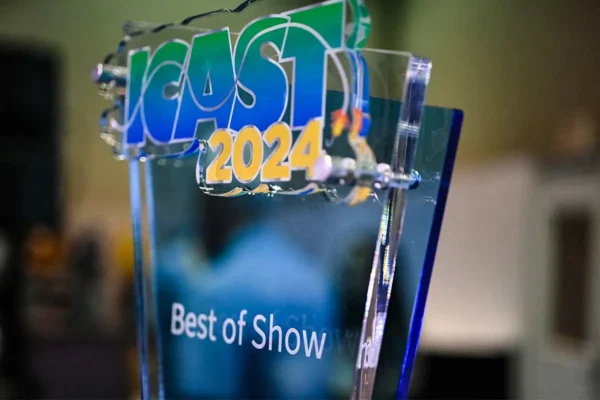This article has been split in two, for the first half please click here.
by Larry Kulchawik
1990-2000: The Age of Technology
New shows and venues continued to grow. During this period, tradeshow marketing was looked to be a valuable investment in the marketing mix for most companies. With the rising number of shows and a strong business belief in tradeshow marketing came the rising costs to exhibit. The cost to rent space on the show floor, and cost to build a classy exhibit began to rise. The on-site cost to handle materials shipped to the site, and the cost for labor to install were two major cost drivers. The word ‘drayage’ and ‘labor unions’ were becoming dirty words.
Reducing costs for drayage and labor at shows was the challenge. “Doing more with less” was the battle cry from exhibitors. As a result, exhibit designers pushed to create solutions to make exhibits lighter, and to reduce the labor cost to install. From this driving desire came portable exhibits, aluminum system exhibits, fabric exhibits, light weight monitors, and independent exhibit installation companies. All exhibit houses employed these new components into their exhibit designs. This period was the start of using hanging fabric signs.
During this very time period came the stronger use of computers and cell phones. All exhibit companies discarded their T-squares, magic markers, and table saws and converted to using CAD design, construction drawings, and CNC for wood cutting. This new technology was not quickly embraced by builders due to cost but was eventually embraced due to the time saved.
CAD technicians began to replace carpenters skills. Assembly of parts was the skill needed.
2000-2010: Tradeshows Mean Business!
While the power of tradeshows remained strong, 9/11 and economic downturns realigned CFO priorities to begin working with their sales and marketing managers. The purchasing agent started working with the exhibits manager. There were more shows for companies to consider and budgeting to get the greatest return became decisions beyond the purview of marketing manager. Companies wanted to increase sales through shows without spending a fortune. Shows got bigger and tradeshow investment did not get cheaper. Exhibitors at smaller shows used portables and set them up themselves. For the larger shows, exhibit materials were lighter, but now incorporated overhead lighting trusses, fabric signs, and monitors for a stronger image.
The labor costs shifted to using exhibit walls, monitors, live presentations, fabric graphics, and overhead truss for lighting. This was the start of the visitor experience approach to exhibit design, and the start of measuring the value of each prospect. CFO’s wanted justification for their tradeshow investments. Most all exhibit supplier companies provided tools for exhibit measurement, cost control, and engagement tactics to their clients. Las Vegas and Orlando became the top venue locations for shows. They matched floor space availability, saved on costs, and were located in appealing locations for a stronger emotional experience. “Tradeshows mean business” was the battle cry.
2010- 2020: Experiential Technology International
Exhibit design and builder companies now became agencies for three dimensional marketing. Exhibit design needed to create an image and to deliver an experience for visitors to remember. Design may include multiple attractions from live presentations, visitor engagement tactics, smartphones, and high quality video stimulation. New companies with dedicated specialties (lead management, live presentations, exhibitor engagement) were formed and partnered with exhibit companies. Exhibit companies began to merge with other exhibit companies to expand their offerings. At this stage, the show contractor companies also began to expand their services, now offering exclusive AV and Lighting services, lead measurement tools, marketing services and exhibit design and build. Since many exhibitor companies were now expanding their reach globally, the exhibit companies began to provide global services. Exhibit houses offered rentals, portables, systems, fabric, and international exhibit services. Industry suppliers established international partners and quickly learned the different ways of designing and participating in shows abroad.
2020-2024: Rediscovering the Human Element
The COVID years forced all companies to uncover new ways of communicating. The exhibitors and the exhibit companies who survived those years experimented with many different digital ways to assist their customers. The virtual tradeshow concept was one way that created an opportunity for attendees to participate throughout the world at any given show. But what it lacked was the power of the human element, it lacked emotion.
People buy from people they trust. The decision to purchase becomes emotional, especially when buying big ticket items. Tradeshows are not like shopping on the internet from a cell phone. Face-to-face marketing creates human interaction that serves to enhance a decision to buy. Aside from introducing and selling products, trade events provide the added benefits of educational sessions and networking with industry peers. This is not achieved as effectively with digital methods.
As a result of experimenting for two years, all companies uncovered many new digital methods of communicating for business. The power of tradeshows has made an amazing comeback from 2020. People want to get out and see real people again. Tradeshow design today incorporates the new digital methods that blend with the stationary methods of the past.
We all have acquired a new friendly attitude towards technology. Exhibitors incorporate digital ways to visit with a customer who is not physically there. This hybrid thinking about communication has changed traditional design for exhibits at tradeshows. Attracting attendees to visit your booth space can now be achieved through both in person engagement as well as digital engagement. Both work, but one is more powerful than the other. Some may differ here, but the worst case would be no communication. All businesses rely on effective communication between buyers and sellers.
Is it no wonder why the top two convention cities in the USA are in attractive locations? The power of tradeshow and events is created with face-to-face marketing where emotion plays a role. Tradeshows do mean business, but don’t underestimate the power of the events location to encourage attendees to experience their personal desires as well as their business desires.
Attending a tradeshow should not be viewed as a job, but as a positive experience that makes you want to grin.
New tradeshow methods continue to unfold to support the power of in-person engagement. The investments made to do so will continue to be watched closely until a stronger alternative surfaces. For now, the magic of tradeshows is still very much embraced.
The History of the Evolution of Tradeshow Labor began in Exhibit City News’ 2024 quarter 1 print.
This article has been split in two, for the second half please click here.
The History of the Evolution of Tradeshow Labor will continue in Exhibit City News’ 2024 quarter 3 print.
This story originally appeared in the Q2 2024 issue of Exhibit City News, p. 80. For original layout or to read the full story, visit https://issuu.com/exhibitcitynews/docs/ecn_q2_2024.































